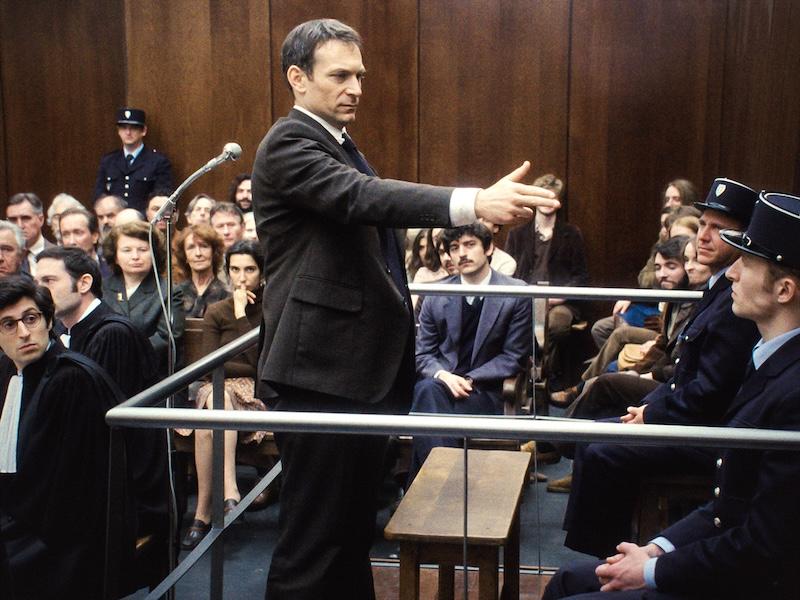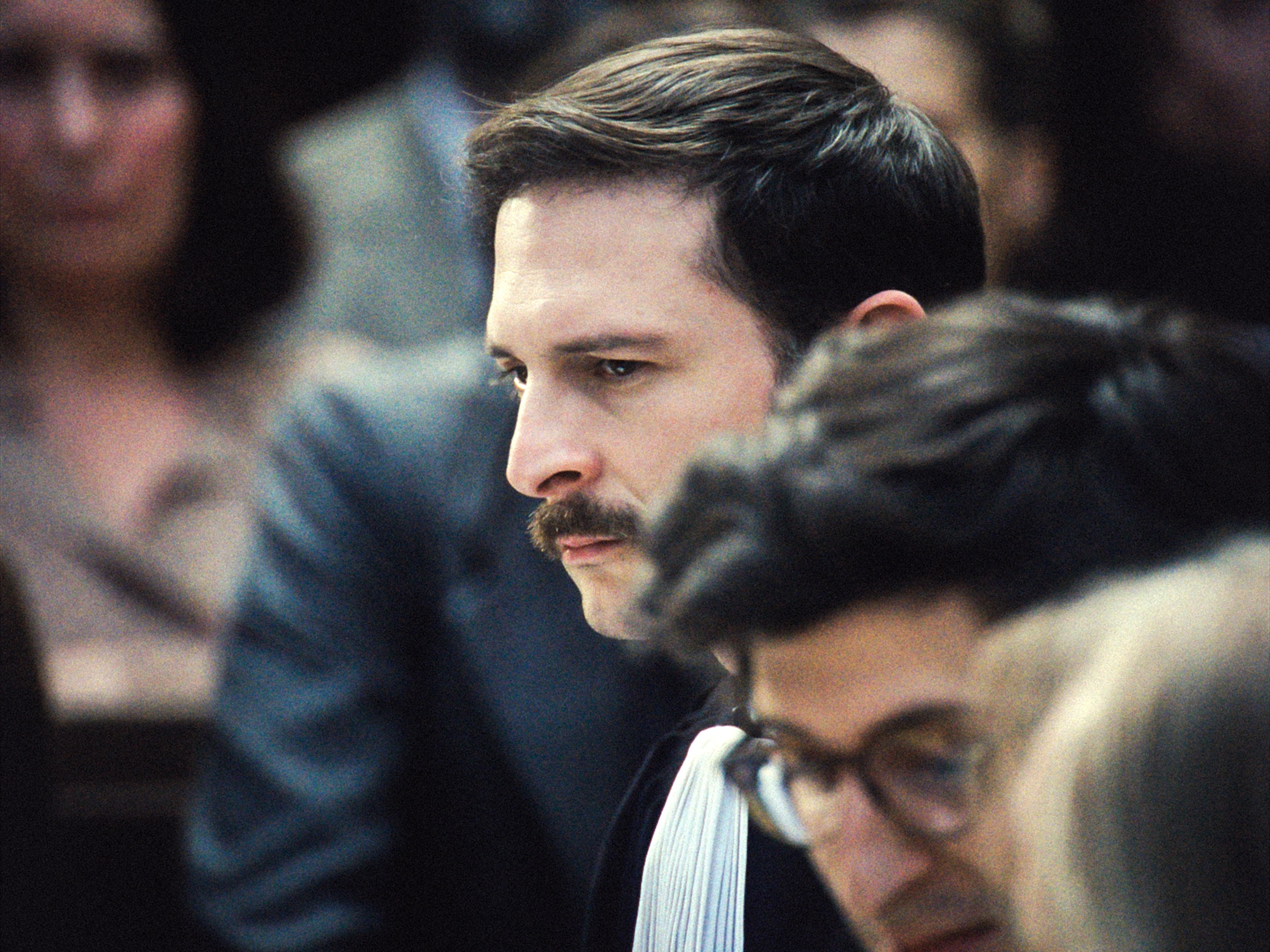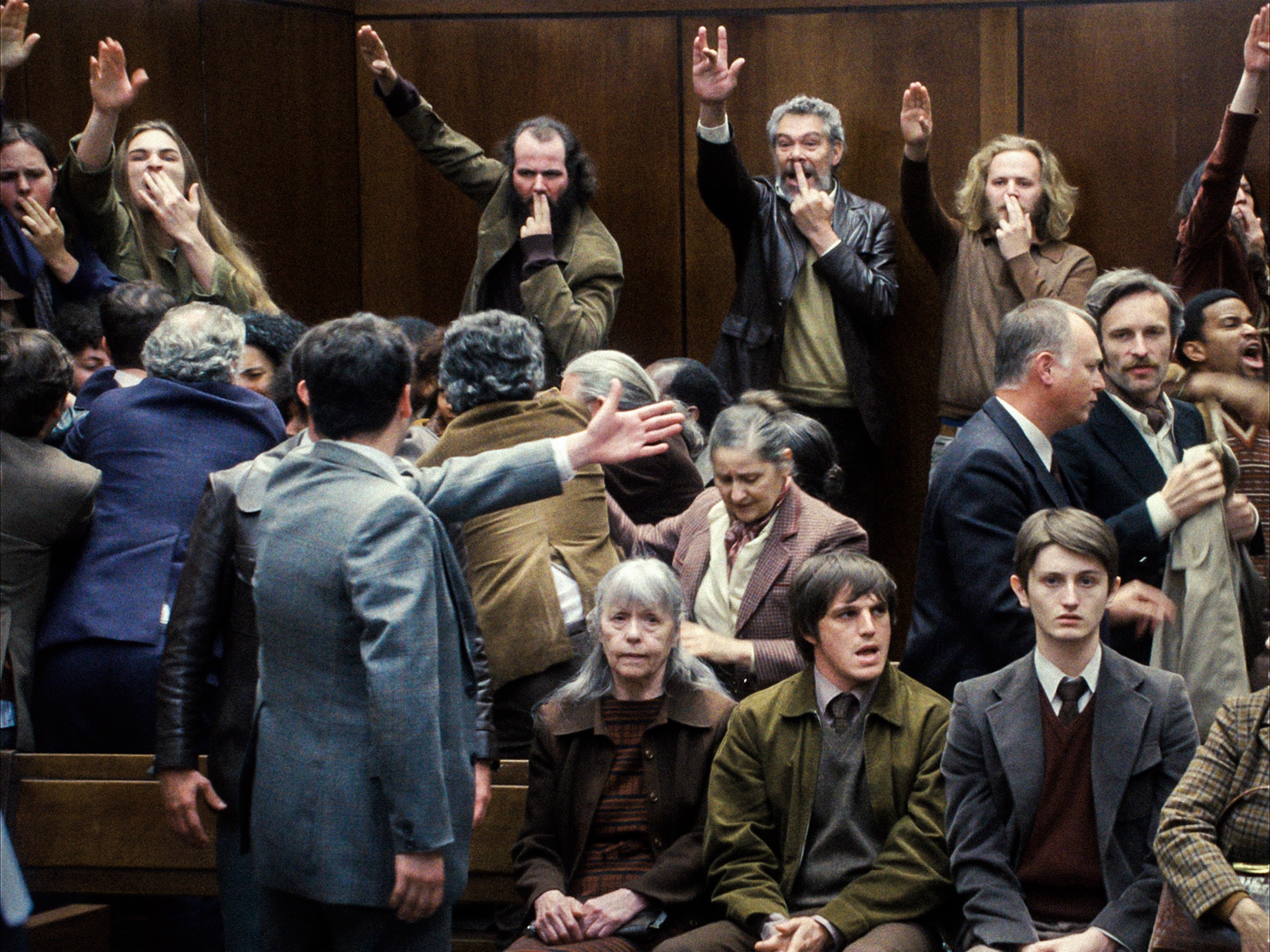The law's sick voyeurism - director Cédric Kahn on 'The Goldman Case' | reviews, news & interviews
The law's sick voyeurism - director Cédric Kahn on 'The Goldman Case'
The law's sick voyeurism - director Cédric Kahn on 'The Goldman Case'
Kahn's drama about the 1976 trial of Pierre Goldman mirrors conflicts in modern France

The trial of the left-wing intellectual Pierre Goldman, who was charged in April 1970 with four armed robberies, one of which led to the death of two pharmacists, was known as “The Trial of the Century” – even though the century wasn’t over yet, as one of the prosecutors quipped.
It is over now, of course, but even though the events explored in Cédric Kahn’s semi-biographical courtroom drama unfolded more than half a century ago, there’s an electrifying currency to the film, which touches on a marvellous array of French discontents harking back to the Dreyfus Affair. At the same time its treatment of institutional racism makes for a very contemporary and relevant piece of filmmaking on the frontline of a culture war that still rages.
The screenplay, which Kahn co-wrote with Nathalie Hertzberg, draws from interviews, news reports, and legal records. Hardly moving outside the courtroom, it offers a claustrophobic but absorbing account of an almost forgotten time of polarisation and violent conflict. Yet, as Kahn points out, the turbulence of that era has never stopped casting a shadow over our own.
“At first, I thought we were making an historical film,” he told me, speaking in London this week ahead of the film’s UK release. “But soon we began to see that the political context and French society haven’t really changed much since the 1970s. I observe lots of constants anyway.”
Pierre Goldman was a bizarre and self-contradictory figure. The son of Polish Jews who fought in the French Resistance during World War II, he became a revolutionary, in his own words, “to relieve [him]self of the stigma of being a Jew”. Yet, being typically French, he also liked smart cars, fine wine, and fancy restaurants. A disciple of Che Guevara, whose funeral in Havana he attended, and later a failed Venezuelan guerrilla, he returned to Paris in time to disparage the “imaginary takeover” of the student uprisings in May 1968, and then – in a move straight out of a Jean-Luc Godard movie – turned to robbery in order to fund his lifestyle. “The revolution is now a tawdry consumer item,” the judge tells him. “You have joined the capitalist system you wanted to annihilate.”
In Kahn’s film, Arieh Worthalter gives an astonishing performance as Goldman, wonderfully conveying his mercurial hauteur and martyred poetic riffs: “I am innocent because I am innocent,” he tells the court bluntly.
Kahn explains that he was drawn to the story of Goldman, a fellow Jew, by his many contradictions and by his obdurate refusal to pander to the legal process. “I believe Goldman believed in his innocence. But he was also a mysterious figure who felt the justice system was unable to punish him any further because he was already punishing himself for not being a partisan like his parents. His curse was to be living too late. The Prague Spring was over, Guevara was dead. He would have preferred to live a more dramatic life.” (Pictured below: Arthur Harari as defence lawyer Georges Kiejman) In his retrial, having confessed to the armed robberies, Goldman is found not guilty by a majority of eight jurors. Was he innocent, then? The film itself refuses to commit to one version of the truth over another, and Kahn himself seems impatient with the question. Indeed, one of the key pleasures of the movie is its uncertainty – the nagging doubts that remain, and the sense that a crucial piece of the jigsaw is always tantalisingly out of reach.
In his retrial, having confessed to the armed robberies, Goldman is found not guilty by a majority of eight jurors. Was he innocent, then? The film itself refuses to commit to one version of the truth over another, and Kahn himself seems impatient with the question. Indeed, one of the key pleasures of the movie is its uncertainty – the nagging doubts that remain, and the sense that a crucial piece of the jigsaw is always tantalisingly out of reach.
“Yes, I have my own opinion about the case,” Kahn says, “but that’s not important. I was interested in Goldman as a character obviously but I also wanted to make a film about justice. I wanted to show that justice is like a spectacle, it’s a world of theatre. The courtroom is a place of words and of speechmaking.”
The courtroom drama is a genre prone to verbose dialogue but The Goldman Case is dynamic and yet somehow also monumental. The mise-en-scène enfolds a hostile legal environment, the physical structure of the Amiens courtroom, which feels very gladiatorial because it’s partly in the round. Kahn’s camera acts as a perspective lens, zooming and reverse zooming, panning and rotating, providing a sense of coherence and objectivity, rather like the ideal of justice itself, with close-ups within the courtroom chaos able to see the situation from diverse angles. It’s almost as if the camera here represents the ideal of justice – providing distance for objectivity and close-ups for intimacy on the faces of the prosecutors in their goofy gowns and frilly collars, of the corrupt police witnesses and of the bewildered-looking jury who will ultimately decide Goldman’s fate.
With the same distilled storytelling that distinguished Steve McQueen’s Mangrove (2020), also set in the early 1970s, and focussing on the Old Bailey trial of nine West Indian activists charged with protesting against police racism in Notting Hill, The Goldman Case highlights the institutional racism of the twin pillars of policing and the justice system.
It’s a curious fact that Kahn’s film should follow in the wake not only of Mangrove but also of Aaron Sorkin’s The Trial of the Chicago 7, about the trial during the same era of anti-Vietnam war demonstrators. (The Chicago Seven were charged alongside Bobby Seale, who was a leader of the Black Panther Party, to which three of the Mangrove Nine – Altheia Jones, Darcus Howe and Barbara Beese – and Joël Lautric, who provided Goldman with his alibi, also belonged.) However, unlike Sorkin, who is unapologetically partisan in his politics, Kahn takes a more nuanced view of left-wing militancy.
The Goldman Case was a circus, an outsize burlesque of a trial, yet it was also a deeply serious battle over who can say what – and how – in the French Fifth Republic. As a docudrama, Kahn’s film is layered and enthralling. The jokester Goldman often disrupts the proceedings, speaking out of turn, winning laughs from the public gallery, but his emphatic playacting also gives way to moments of subtlety, many of which come from the defence lawyer Georges Kiejman, an intriguing mixture of pragmatism and inscrutability. Arthur Harari, who plays Kiejman, knows a thing or two about courtroom dramas that refuse to take sides, having won an Oscar for writing Anatomy of a Fall (2023) with his partner Justine Triet, its director.
That rivalry between Goldman and Kiejman – the clash between the “Jewish warrior” and the “armchair Jew” hired to defend him – is the engine of Kahn’s plot, giving shape and momentum to the sprawling pageant of the courtroom.
“This is one of the most interesting aspects of the story for me, the relationship between these two Jews, both from Polish Jewish families,” Kahn says. “Goldman is the ‘victim’ Jew, the tragic Jew, while Kiejman is the assimilated Jew, who has integrated into society, the ‘successful’ Jew, and I think you find both types in most Jewish families in France, the so-called ‘street Jews’ and then ‘the Jews of the court’.”
 The film opens with Goldman denouncing the “law’s sick voyeurism” as he tries to sack Kiejman on the eve of his retrial, and there is real fervour and real meaning here: because this is filmmaking with visceral understanding of the voyeurism of trial movies, including The Goldman Case and Anatomy of a Fall.
The film opens with Goldman denouncing the “law’s sick voyeurism” as he tries to sack Kiejman on the eve of his retrial, and there is real fervour and real meaning here: because this is filmmaking with visceral understanding of the voyeurism of trial movies, including The Goldman Case and Anatomy of a Fall.
“The process is just a lieu [setting], the process is just context,” Kahn says. “In both these films, the trial is a place of storytelling, but of course they are very different films. In Anatomy of a Fall, the storytelling refers to a family, a couple. The Goldman Case tells a story about French society, about politics, about the history of the Jews. But yes, in both cases, there is no objective truth, only words. The courtroom is a place of speech.”
Nodding to Hollywood trial movies such as Sidney Lumet’s Twelve Angry Men (1957), Otto Preminger’s Anatomy of a Murder (1959), and Stanley Kramer’s Inherit the Wind (1960), with their hopeful commentaries about the American legal system, and to more recent examples such as The People v. O.J. Simpson (2016) and Alice Diop’s compelling Saint Omer (2022), Kahn’s film lays out a teasingly complex framework that repeatedly tips the audience off balance and taps into our biases and assumptions. Because the film isn’t just about a trial, it also has its own trial logic: it’s actually structured like a trial, as if the legal system itself was in the dock – here's some evidence, here's some opposing evidence, etc. – until, as De Tocqueville said, the courtroom comes to resemble a kind of microcosm of democracy in practice.
In his closing speech, Kiejman calls Goldman a Dostoyevskian hero, Raskolnikov in Crime and Punishment or Prince Myshkin in The Idiot, alluding to the undeniable fictiveness of all stories and perhaps also to the law’s conspiratorial role in crafting them.
“There is a problem with the French Left and the law, an entanglement with the law that complicates things for the Left and helps to explain a character like Goldman,” Kahn observes. “The French left always had a certain complacency about violence, a complacency about the law, and in many cases that resulted in a lack of ideals.”
But not in Goldman’s case perhaps. Toward the end of the film he refuses to identify the police informer X2 who could prove his innocence, saying, “I’ve kept a shred of heroism in this process by refusing to rat on anyone.” The Goldman Case is that rare thing, a profound movie about the 1970s without a shred of wafting patchouli or tie-dye clichés.
- More film on theartsdesk
The future of Arts Journalism
You can stop theartsdesk.com closing!
We urgently need financing to survive. Our fundraising drive has thus far raised £49,000 but we need to reach £100,000 or we will be forced to close. Please contribute here: https://gofund.me/c3f6033d
And if you can forward this information to anyone who might assist, we’d be grateful.

Subscribe to theartsdesk.com
Thank you for continuing to read our work on theartsdesk.com. For unlimited access to every article in its entirety, including our archive of more than 15,000 pieces, we're asking for £5 per month or £40 per year. We feel it's a very good deal, and hope you do too.
To take a subscription now simply click here.
And if you're looking for that extra gift for a friend or family member, why not treat them to a theartsdesk.com gift subscription?
more Film
 The Perfect Neighbor, Netflix review - Florida found-footage documentary is a harrowing watch
Sundance winner chronicles a death that should have been prevented
The Perfect Neighbor, Netflix review - Florida found-footage documentary is a harrowing watch
Sundance winner chronicles a death that should have been prevented
 Blu-ray: Le Quai des Brumes
Love twinkles in the gloom of Marcel Carné’s fogbound French poetic realist classic
Blu-ray: Le Quai des Brumes
Love twinkles in the gloom of Marcel Carné’s fogbound French poetic realist classic
 Frankenstein review - the Prometheus of the charnel house
Guillermo del Toro is fitfully inspired, but often lost in long-held ambitions
Frankenstein review - the Prometheus of the charnel house
Guillermo del Toro is fitfully inspired, but often lost in long-held ambitions
 London Film Festival 2025 - a Korean masterclass in black comedy and a Camus classic effectively realised
New films from Park Chan-wook, Gianfranco Rosi, François Ozon, Ildikó Enyedi and more
London Film Festival 2025 - a Korean masterclass in black comedy and a Camus classic effectively realised
New films from Park Chan-wook, Gianfranco Rosi, François Ozon, Ildikó Enyedi and more
 After the Hunt review - muddled #MeToo provocation
Julia Roberts excels despite misfiring drama
After the Hunt review - muddled #MeToo provocation
Julia Roberts excels despite misfiring drama
 London Film Festival 2025 - Bradley Cooper channels John Bishop, the Boss goes to Nebraska, and a French pandemic
... not to mention Kristen Stewart's directing debut and a punchy prison drama
London Film Festival 2025 - Bradley Cooper channels John Bishop, the Boss goes to Nebraska, and a French pandemic
... not to mention Kristen Stewart's directing debut and a punchy prison drama
 Ballad of a Small Player review - Colin Farrell's all in as a gambler down on his luck
Conclave director Edward Berger swaps the Vatican for Asia's sin city
Ballad of a Small Player review - Colin Farrell's all in as a gambler down on his luck
Conclave director Edward Berger swaps the Vatican for Asia's sin city
 London Film Festival 2025 - from paranoia in Brazil and Iran, to light relief in New York and Tuscany
'Jay Kelly' disappoints, 'It Was Just an Accident' doesn't
London Film Festival 2025 - from paranoia in Brazil and Iran, to light relief in New York and Tuscany
'Jay Kelly' disappoints, 'It Was Just an Accident' doesn't
 Iron Ladies review - working-class heroines of the Miners' Strike
Documentary salutes the staunch women who fought Thatcher's pit closures
Iron Ladies review - working-class heroines of the Miners' Strike
Documentary salutes the staunch women who fought Thatcher's pit closures
 Blu-ray: The Man in the White Suit
Ealing Studios' prescient black comedy, as sharp as ever
Blu-ray: The Man in the White Suit
Ealing Studios' prescient black comedy, as sharp as ever
 The Woman in Cabin 10 review - Scandi noir meets Agatha Christie on a superyacht
Reason goes overboard on a seagoing mystery thriller
The Woman in Cabin 10 review - Scandi noir meets Agatha Christie on a superyacht
Reason goes overboard on a seagoing mystery thriller
 London Film Festival 2025 - crime, punishment, pop stars and shrinks
Daniel Craig investigates, Jodie Foster speaks French and Colin Farrell has a gambling habit
London Film Festival 2025 - crime, punishment, pop stars and shrinks
Daniel Craig investigates, Jodie Foster speaks French and Colin Farrell has a gambling habit

Add comment